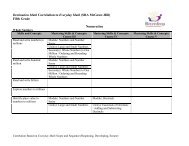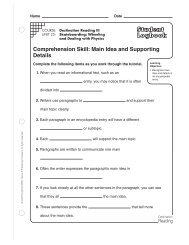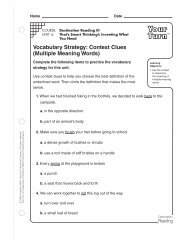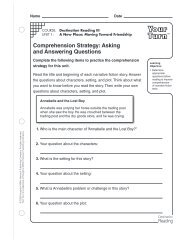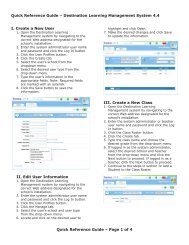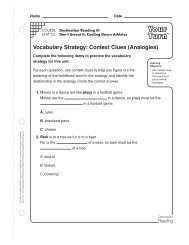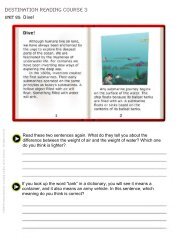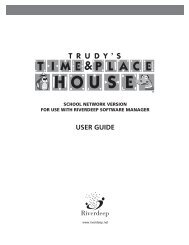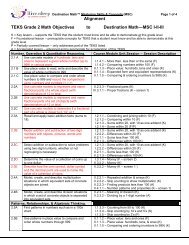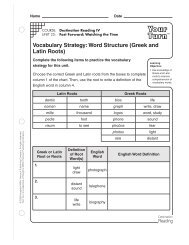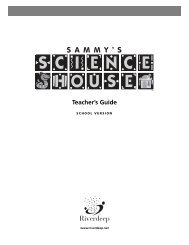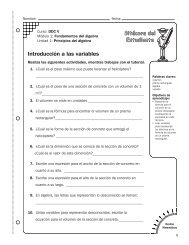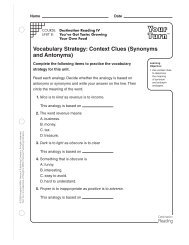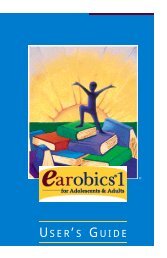Course III Teachers Guide.pdf - Houghton Mifflin Harcourt
Course III Teachers Guide.pdf - Houghton Mifflin Harcourt
Course III Teachers Guide.pdf - Houghton Mifflin Harcourt
Create successful ePaper yourself
Turn your PDF publications into a flip-book with our unique Google optimized e-Paper software.
DESTINATION READINGETTING STARTED1GETTING STARTEDPhilosophy and Research BasisThe U.S. Department of Education reported that in 2005 eight million students in grades four through eight met thecriteria of struggling readers. Literacy challenges impact all areas of performance as reading becomes ever-moreessential to the comprehension of subject-area textbooks. While the challenges are significant, the literacy challenges forgrades four through eight are being addressed. In recent years, a second wave of action has been called for—initiativesto continue the emphasis on literacy through the entire K–12 experience.While research is strong on the basic components of literacy and strategies to help young children learn to read, there ismuch less empirical research and proven practice on the development of reading skills among adolescents and theidentification, prevention, and remediation of reading difficulties in middle and high school students. Approximately 10percent of students still need to develop basic reading skills relating to the alphabetic principle. For a larger group ofadolescent students who have learned basic reading skills in the early grades, vocabulary, fluency, and comprehensioncan be significant challenges beyond elementary school. In addition, such issues as motivation and access to ageappropriatereading materials play a large role in continued development of reading comprehension skills and strategiesas students progress through the grades.Explicit Instruction, <strong>Guide</strong>d Practice, and Authentic ApplicationExplicit instruction in skills and concepts in reading promotes efficient learning. It allows students to understand whatthey’ve read at literal, concept-specific levels and teaches them to use their knowledge at higher levels of thinking inorder to transfer it to new contexts. Applying a consistent explicit-instruction sequence increases the likelihood thatstudents will use strategies for learning.In reading, achievement gains are associated with explicit instruction in reading strategies. In addition to explicitinstruction, learners must have personal, active experiences in practicing and applying new concepts to master a newstrategy. Effective models of instruction include an explicit description of the strategy (including when and how it shouldbe used), modeling of the strategy in action, collaborative use of the strategy, guided practice, and independent use ofthe strategy. The National Reading Panel noted, “Explicit or formal instruction in the application of comprehensionstrategies has been shown to be highly effective in enhancing understanding.” (NICHD, 2000a, p. 14).The report furtherdefined explicit instruction as follows:The steps of explicit instruction typically include direct explanation, teacher modeling (“thinking aloud”), guidedpractice, and application.• Direct explanation The teacher explains to students why the strategy helps comprehension and when to applythe strategy.• Modeling The teacher models, or demonstrates, how to apply the strategy, usually by “thinking aloud” whilereading the text that the students are using.• <strong>Guide</strong>d practice The teacher guides and assists students as they learn how and when to apply the strategy.• Application The teacher helps students practice the strategy until they can apply it independently.This complete cycle helps students develop abilities related to a specific strategy. To ensure that the full range ofstrategies is addressed and that students experience and utilize the strategies with a variety of texts, a systematicapproach is also supported by research.



